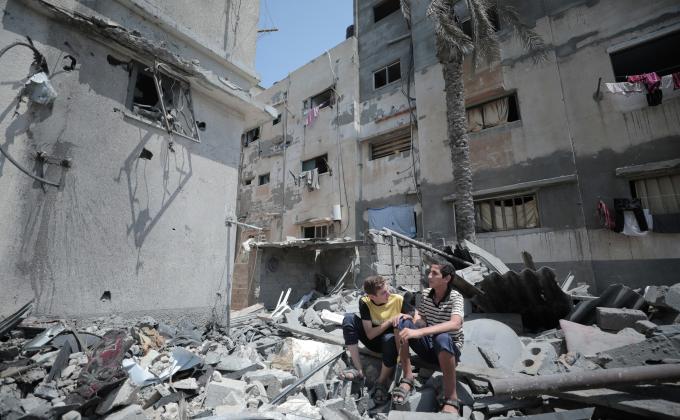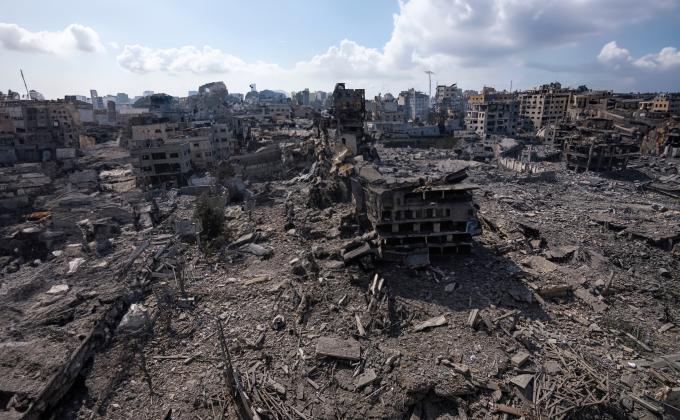As Gaza faces one of the most severe post-war humanitarian crises in modern history, a crucial policy debate emerges: will displacement camps emerge to serve as a temporary humanitarian necessity, or become long-term internment sites potentially fuelling future radicalisation and conflict?
Over twenty months into the Israel-Hamas war, the Gaza Strip’s infrastructure currently lies in an exceptionally critical state. An estimated 60 percent of Gaza’s buildings have been damaged or destroyed, including 92 percent homes. Beyond widespread infrastructural damage, the humanitarian situation across Gaza is similarly dire. Over 90 percent of the population has been internally displaced, with nearly one million residents currently without adequate shelter and essential services. Meanwhile, although a fragile ceasefire brokered by the United States, Qatar, and Egypt had initially held, thousands of Hamas and affiliated armed group members reportedly remain active, and a renewed ground campaign to oust them resumed in March.
On 19 May 2025, Israeli Prime Minister Benjamin Netanyahu vowed that Israel would “take control” of all of Gaza – signalling a potentially indefinite military presence. As post-war scenarios emerge, the international community must confront a series of urgent humanitarian, legal, and security questions amid what increasingly appears to be a long-term internal displacement crisis.
Over the past seven years in Syria, the blanket, unlawful internment of civilians fleeing territories previously held by designated terrorist organisations has been used as a counter-terrorism tool. Such measures have been linked to efforts to detain suspected ISIS affiliates without adequate legal processes, subjecting civilians to administrative detention (internment), under the pretext of counter-terrorism and security concerns.
The experience of internment camps following the fall of ISIS in Syria provides valuable insights into some of the legal challenges that may emerge in post-war Gaza, particularly if Israel does in fact assume control over the strip. These insights include addressing security concerns and the risk of radicalisation in humanitarian camps. Drawing parallels between these two contexts, this analysis examines the potential vulnerabilities and necessary interventions in managing displaced populations in a post-war reality.
Internment as a counter-terrorism tool
The status of Hamas as a designated terrorist group, notably by the United States, European Union, and United Kingdom among others, coupled with the combined levels of destruction and internal displacement across Gaza, mean that legitimate terrorism threats can linger on. This is exemplified by the initial ceasefire agreement itself, which involved prisoner and hostage exchanges, where hundreds of Palestinians, including those convicted of serious offenses, were released back into Gaza. Some of these individuals may engage in terrorist attacks, particularly if they return to regions with limited oversight.
Beginning in northeast Syria in May 2017, and following the territorial defeat of ISIS in Syria, tens of thousands of individuals – including suspected ISIS affiliates, family members, victims, witnesses, and others who fled Raqqa and Dayr Az-Zawr governorates – were unlawfully interned en masse simply for residing in areas once controlled by ISIS. These camps are still being administered by the Kurdish-led Autonomous Administration of North and East Syria, the civilian wing of the Syrian Democratic Forces (SDF) armed group. What began as an ignored humanitarian crisis slowly but steadily began drawing global attention and became impossible to overlook, especially as governments initially refused to repatriate their own nationals, including women and children. Many states, including the United Kingdom, continue to refuse repatriation of their adult nationals.
The camps in northeast Syria continue to house several thousand detained Islamic State fighters, as well as some 40,000 interned family members and others from Syria, Iraq, and other third-States. Three such camps, including the sprawling and now ill-famed al-Hol camp, are in Hasaka governorate, and another two in Raqqa governorate. According to its Ministry of Immigration and Displacement, Iraq has repatriated nearly 15,000 of its nationals from al-Hol camp as of February 2025, though some 14,000 Iraqis remain in al-Hol. Tens of thousands of detainees remain in legal limbo, lacking clear pathways for prosecution, repatriation, or reintegration. Women, many of whom were radicalised or coerced into ISIS affiliation, present a complex mix of survivors, perpetrators, and security threats. Children, particularly those born in detention, are among the most vulnerable, and risk statelessness, lack of education, and radicalisation within the camps.
To date, the operational environment in the camps remains extremely complex with both the security situation and living conditions continuously deteriorating. There are long-term security and humanitarian risks due to overcrowding, disease, malnutrition, and gender-based violence which has been rampant, and all of which have been exacerbated by the US funding freeze pursuant to Executive Order 14169.
Lesser known, however, is that similar tactics were employed in besieged eastern Ghouta. Beginning in February 2018, those living in eastern Ghouta under Jaysh al-Islam and Hay’at Tahrir al-Sham, the latter a UN designated terrorist entity, were all interned unlawfully upon the lifting of the siege. Government forces rounded up approximately 95,000 civilians including women and children who fled through humanitarian corridors and transported them in buses to eight collective shelters scattered across Rif Damascus governorate, and screened each for their potential ties to terrorism.
Applicable law
Internment means administrative or security detention. Under international law, various legal frameworks govern the internment of civilians depending on the classification of the armed conflict. During International Armed Conflict (IAC) between two or more states, the internment of civilians is governed by the Fourth Geneva Convention (GC IV). Civilians may be interned only on a case-by-case basis, if they pose an imperative security risk (Article 78, GC IV), and such internment must not be arbitrary or punitive. Internment decisions must be reviewed regularly (at least every six months) by a competent authority (Articles 43 and 78, GC IV), and detainees retain the right to humane treatment, legal recourse, and access to basic needs (Articles 27, 32–33, GC IV). Additionally, the transfer of detainees to another state is prohibited if there is a risk of inhumane treatment (Article 45, GC IV).
In a Non-International Armed Conflict (NIAC) between a State and armed group(s), or between two or more armed groups, IHL does not explicitly regulate the legal basis for civilian internment. Common Article 3 of the Geneva Conventions and customary IHL, however, mandate the humane treatment of all persons deprived of liberty. While internment is not prohibited in NIACs, IHL does not establish clear procedural safeguards, leaving such regulation to domestic law and human rights law, which prohibit arbitrary detention and require due process guarantees (see below).
When a State exercises effective control over a territory, it is considered occupied under IHL and the law of occupation becomes applicable – a determination made by the Prosecutor of the International Criminal Court (ICC) for northern Gaza. Under this framework, the internment of civilians is permitted only as an exceptional measure and must be based on “imperative reasons of security” (Article 78, GC IV). It therefore cannot be used as a routine tactic, nor for intelligence-gathering or interrogation. If a civilian is interned, their detention must be subject to regular review by a competent authority (Article 43(1)), and they are entitled to a timely review at least every six months (Articles 43(1) and 78(2)). Crucially, IHL strictly prohibits arbitrary detention (Articles 27, 32–33, 42, and 78), ensuring that any deprivation of liberty complies with legal safeguards and is not used as a form of collective punishment or oppression (para. 1134).
The role of Israel and international actors in managing any humanitarian camps in Gaza will also have significant implications for the legality and legitimacy of such facilities under international human rights law (IHRL), which applies alongside IHL in situations of armed conflict and occupation. Under IHRL, a series of international standards apply universally to ensure the dignity, safety, and legal rights of anyone deprived of liberty, and must be respected without discrimination, regardless of the circumstances or legal status of the individual. States conducting detention during armed conflict must respect certain minimum obligations, including ensuring detainees’ right to life (Article 6, ICCPR) and protection from arbitrary detention (Article 9, ICCPR). Interned civilians must also be provided with adequate living conditions, including food, water, shelter (Article 11, ICESCR), and access to healthcare (Article 12, ICESCR). Importantly, a state also cannot outsource these core human rights obligations onto humanitarian aid organisations, irrespective of the state’s economic situation or budgetary considerations. Finally, interned individuals have the right to legal counsel and the ability to challenge their detention (Article 14, ICCPR).
Under Israeli domestic law, administrative detention is governed by Military Order 1651, the 1979 Emergency Powers Law, and the 2002 Unlawful Combatants Law, which allow for indefinite detention without trial for security threats. Critics note that such detentions are often based on secret evidence and lack independent judicial review, which raises human rights concerns over arbitrary detention, ill-treatment, and collective punishment, particularly when applied to civilians based on geographic proximity or familial association with armed group members. Extended review periods and limited legal access seriously exacerbate these issues, directly paralleling indefinite internment in Syria.
Risks of radicalisation and security in prolonged detention
The absence of adhering to international law and the legal framework(s) governing indefinite administrative detention in northeast Syria has not only raised serious human rights concerns but has also exacerbated security threats by enabling ISIS remnants to sustain recruitment and operational capabilities. Historical parallels with Camp Bucca in post-2003 Iraq, for example, demonstrate how unregulated detention environments function as “jihadi universities,” fostering militant cohesion, ideological hardening, and operational coordination.
The lack of effective governance in northeast Syria has already led to documented ISIS activity within the camps there, including orchestrated escapes and coordinated attacks. The fall of the Assad regime in December 2024 has intensified this instability, posed a strain on the limited capacity of the local (SDF) authorities, and injected fresh uncertainty into an already volatile region, further straining the fragile control over these facilities. Inside camps such as al-Hol, internal violence, including killings and sexual violence, have posed severe risks to both encamped residents and humanitarian workers. Overall, it has become clear that rehabilitation and monitored reintegration programmes – rooted in psychological disengagement models and tailored risk-mitigation strategies – must take precedence over indefinite unlawful internment.
The conditions in al-Hol camp illustrate how prolonged internment without legal adjudication, reintegration pathways, or security oversight create an environment ripe for further radicalisation. ISIS recruiters and ideological enforcers have exploited the power vacuum, overcrowding, and humanitarian neglect to reinforce their networks, maintain ideological cohesion, and indoctrinate detainees, particularly children and adolescents, who lack alternative pathways. Recent intelligence assessments indicate that these camps are not merely passive holding areas but active incubators for the next generation of extremist operatives, with sleeper cells embedded within civilian populations. The failure to repatriate and/or prosecute civilian internees, coupled with poor living conditions and the absence of rehabilitation programmes, fuels resentment, strengthens extremist narratives, and perpetuates a cycle of radicalisation, posing an enduring threat to regional and global security.
Gaza
Given the scale of devastation, and in the absence of a full-scale population relocation – which would raise serious legal and ethical concerns – the need for humanitarian camps is becoming increasingly urgent and is being supported by several countries. Across Gaza, approximately 92 percent of homes and more than half of the hospitals and medical facilities have been partially damaged or completely destroyed. On 9 March 2025, leading European nations including France, Germany, Italy, and the United Kingdom said they would support a comprehensive plan for the reconstruction of Gaza, crafted by Egypt and backed by Arab leaders, that would cost $53 billion USD. The implementation of the plan requires building several largescale “temporary housing” camps distributed along the Salah al-Din axis, which would prevent the largescale forced displacement of Palestinians from the area, and counter President Trump’s plan to take “a long-term ownership position” of Gaza.
The looming scenario in post-war Gaza
As demonstrated above, the potential for unlawful internment of civilians arises when broad counter-terrorism and security measures fail to distinguish between fighters and civilians, leading to the detention of individuals based solely on their presence in conflict zones or associations with certain groups. The indefinite internment of thousands in Syria has underscored just how counter-terrorism justifications can erode legal protections, ultimately fostering greater security risks. As noted by Egypt’s comprehensive plan for the reconstruction of Gaza, the sheer levels of destruction in Gaza necessitate large-scale humanitarian camps and caravans, but, without clear adherence to international law, these sites risk becoming long-term detention centres, replicating the failures of Syria’s internment camps. Unlike Syria’s al-Hol, however, Gaza’s density and near-total destruction of infrastructure complicate camp logistics. Moreover, internment in Gaza would occur under prolonged occupation, whereas Syria’s camps were managed by non-state actors (such as SDF), underscoring the heightened risk of mass detention under Israel’s effective control, with fewer avenues for oversight.
In several instances, Israeli forces have reported discovering weapons caches, tunnel entrances, or communications infrastructure in or near civilian sites, including those used as shelters in Gaza. These claims have been used to justify widespread detentions, often under administrative detention without formal charges. For example, as armed group members may continue to blend into civilian populations including through plainclothes disguises and by using residential homes, they may also similarly use displacement sites as cover. Overcrowded shelters and camps can become hubs for militant activity, weapons storage, or recruitment, complicating efforts to distinguish between civilians and combatants, creating spaces where armed actors may operate with relative impunity. Indeed, the large-scale movement and concentration of displaced persons would present both intelligence blind spots and operational challenges, fuelling fears of future instability and renewed terrorist attacks. Such detentions may shape future policies regarding humanitarian camp governance, potentially leading to stricter oversight to prevent militant activity. To avoid this, internment must be time-bound, individualised, and subject to independent legal oversight. While a certain measure of security concerns is valid, counter-terrorism policy cannot justify indefinite detention without evidence-based threat assessments, and mechanisms for appeal and release must be in place to prevent arbitrary detention (unlawful internment).
The failures of post-ISIS internment in Syria should also serve as a stark warning: without legal oversight, Gaza’s humanitarian response risks fuelling a long-term security crisis. Beyond ensuring that any detention of encamped residents is conducted pursuant to international law, deradicalisation programmes and unobstructed humanitarian access – including by lifting the current blockade after the war as it concerns construction materials and fuel – are critical to preventing recruitment and radicalisation within camps in the long-term.
Under international law, the burden of humanitarian assistance must not fall solely on aid organisations, but rather a coordinated international response is essential. Regional actors and international bodies should engage in reintegration efforts to prevent any camps in Gaza from becoming long-term internment sites, which would risk further deepening instability. A balanced approach, ensuring security without indefinite detention, and governance without prolonged occupation, is essential to shaping Gaza’s post-war trajectory and to ensuring that the mistakes of northeast Syria do not risk being repeated.
This article represents the views of the author(s) solely. ICCT is an independent foundation, and takes no institutional positions on matters of policy unless clearly stated otherwise.
Photocredit: Anas-Mohammed/Shutterstock








